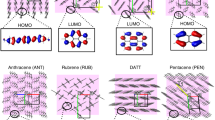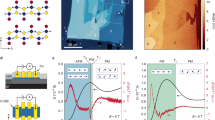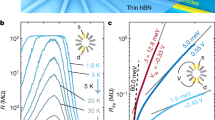Abstract
In the classic transistor, the number of electric charge carriers—and thus the electrical conductivity—is precisely controlled by external voltage, providing electrical switching capability. This simple but powerful feature is essential for information processing technology, and also provides a platform for fundamental physics research1,2,3,4,5,6,7,8,9,10,11,12,13,14,15,16. As the number of charges essentially determines the electronic phase of a condensed-matter system, transistor operation enables reversible and isothermal changes in the system’s state, as successfully demonstrated in electric-field-induced ferromagnetism2,3,4 and superconductivity5,6,7,8,9,10. However, this effect of the electric field is limited to a channel thickness of nanometres or less, owing to the presence of Thomas–Fermi screening. Here we show that this conventional picture does not apply to a class of materials characterized by inherent collective interactions between electrons and the crystal lattice. We prepared metal–insulator–semiconductor field-effect transistors based on vanadium dioxide—a strongly correlated material with a thermally driven, first-order metal–insulator transition well above room temperature17,18,19,20,21,22,23—and found that electrostatic charging at a surface drives all the previously localized charge carriers in the bulk material into motion, leading to the emergence of a three-dimensional metallic ground state. This non-local switching of the electronic state is achieved by applying a voltage of only about one volt. In a voltage-sweep measurement, the first-order nature of the metal–insulator transition provides a non-volatile memory effect, which is operable at room temperature. Our results demonstrate a conceptually new field-effect device, extending the concept of electric-field control to macroscopic phase control.
This is a preview of subscription content, access via your institution
Access options
Subscribe to this journal
Receive 51 print issues and online access
$199.00 per year
only $3.90 per issue
Buy this article
- Purchase on Springer Link
- Instant access to full article PDF
Prices may be subject to local taxes which are calculated during checkout




Similar content being viewed by others
References
Ahn, C. H. et al. Electrostatic modification of novel materials. Rev. Mod. Phys. 78, 1185–1212 (2006)
Ohno, H. et al. Electric-field control of ferromagnetism. Nature 408, 944–946 (2000)
Yamada, Y. et al. Electrically induced ferromagnetism at room temperature in cobalt-doped titanium dioxide. Science 332, 1065–1067 (2011)
Chiba, D. et al. Electrical control of the ferromagnetic phase transition in cobalt at room temperature. Nature Mater. 10, 853–856 (2011)
Glover, R. E. & Sherrill, M. D. Changes in superconducting critical temperature produced by electrostatic charging. Phys. Rev. Lett. 5, 248–250 (1960)
Ahn, C. H. et al. Electrostatic modulation of superconductivity in ultrathin GdBa2Cu3O7-x films. Science 284, 1152–1155 (1999)
Caviglia, A. D. et al. Electric field control of the LaAlO3/SrTiO3 interface ground state. Nature 456, 624–627 (2008)
Ueno, K. et al. Electric-field-induced superconductivity in an insulator. Nature Mater. 7, 855–858 (2008)
Ye, J. T. et al. Liquid-gated interface superconductivity on an atomically flat film. Nature Mater. 9, 125–128 (2010)
Bollinger, A. T. et al. Superconductor-insulator transition in La2-xSrxCuO4 at the pair quantum resistance. Nature 472, 458–460 (2011)
Newns, D. M. et al. Mott transition field effect transistor. Appl. Phys. Lett. 73, 780–782 (1998)
Kawasugi, Y. et al. Field-induced carrier delocalization in the strain-induced Mott insulating state of an organic superconductor. Phys. Rev. Lett. 103, 116801 (2009)
Mathews, S., Ramesh, R., Venkatesan, T. & Benedetto, J. Ferroelectric field effect transistor based on epitaxial perovskite heterostructures. Science 276, 238–240 (1997)
Hong, X., Posadas, A., Lin, A. & Ahn, C. H. Ferroelectric-field-induced tuning of magnetism in the colossal magnetoresistive oxide La1-xSrxMnO3 . Phys. Rev. B 68, 134415 (2003)
Asanuma, S. et al. Tuning of the metal-insulator transition in electrolyte-gated NdNiO3 thin films. Appl. Phys. Lett. 97, 142110 (2010)
Scherwitzl, R. et al. Electric-field control of the metal-insulator transition in ultrathin NdNiO3 films. Adv. Mater. 22, 5517–5520 (2010)
Morin, F. J. Oxides which show a metal-to-insulator transition at the Neel temperature. Phys. Rev. Lett. 3, 34–36 (1959)
Barker, A. S., Verleur, H. W. & Guggenheim, H. J. Infrared optical properties of vanadium dioxide above and below the transition temperature. Phys. Rev. Lett. 17, 1286–1289 (1966)
Berglund, C. N. & Guggenheim, H. J. Electronic properties of VO2 near the semiconductor-metal transition. Phys. Rev. 185, 1022–1033 (1969)
Goodenough, J. B. The two components of the crystallographic transition in VO2 . J. Solid State Chem. 3, 490–500 (1971)
Wentzcovitch, R. M., Schulz, W. W. & Allen, P. B. VO2: Peierls or Mott-Hubbard? A view from band theory. Phys. Rev. Lett. 72, 3389–3392 (1994)
Rice, T. M., Launois, H. & Pouget, J. P. Comment on “VO2: Peierls or Mott-Hubbard? A view from band theory”. Phys. Rev. Lett. 73, 3042 (1994)
Qazilbash, M. M. et al. Mott transition in VO2 revealed by infrared spectroscopy and nano-imaging. Science 318, 1750–1753 (2007)
Shibuya, K., Kawasaki, M. & Tokura, Y. Metal-insulator transition in epitaxial V1-xWxO2 (0 ≤ x ≤ 0.33) thin films. Appl. Phys. Lett. 96, 022102 (2010)
Muraoka, Y. & Hiroi, Z. Metal-insulator transition of VO2 thin films grown on TiO2 (001) and (110) substrates. Appl. Phys. Lett. 80, 583–585 (2002)
Cavalleri, A. et al. Femtosecond structural dynamics in VO2 during an ultrafast solid-solid phase transition. Phys. Rev. Lett. 87, 237401 (2001)
Cavalleri, A. et al. Band-selective measurements of electron dynamics in VO2 using femtosecond near-edge X-ray absorption. Phys. Rev. Lett. 95, 067405 (2005)
Kim, H. T. et al. Mechanism and observation of Mott transition in VO2-based two- and three-terminal devices. N. J. Phys. 6, 052 (2004)
Boriskov, P. P., Velichko, A. A., Pergament, A. L., Stefanovich, G. B. & Stefanovich, D. G. The effect of electric field on metal-insulator phase transition in vanadium dioxide. Tech. Phys. Lett. 28, 406–408 (2002)
Ruzmetov, D., Gopalakrishnan, G., Ko, C., Narayanamurti, V. & Ramanathan, S. Three-terminal field effect devices utilizing thin film vanadium oxide as the channel layer. J. Appl. Phys. 107, 114516 (2010)
Acknowledgements
We are grateful to K. Ueno, H. T. Yuan, J. T. Ye, H. Shimotani, Y. Kasahara and T. Takenobu for discussions, and to T. Arima, H. Ohsumi, S. Takeshita, S. Tardif and Y. Kitagawa for support for X-ray diffraction measurements. This work was supported by the Japan Society for the Promotion of Science (JSAP) through its ‘Funding Program for World-Leading Innovative R&D on Science and Technology (FIRST Program)’. M.N. was supported by RIKEN through the Incentive Research Grant. K.S. was supported by Grants-in-Aid for young scientists (category B, grant number 22760016). Y.I. was partly supported by Grants-in-Aid for Scientific Research (category S, grant number 21224009). The synchrotron X-ray diffraction experiments were performed at BL19LXU in SPring-8 with approval of RIKEN (proposal number 20110091).
Author information
Authors and Affiliations
Contributions
M.N. fabricated the devices, performed the measurements and analysed the data. K.S. grew the films. M.N. and D.O. performed the X-ray diffraction measurements under gating. T.H. and S.O. contributed to device fabrications and the experimental setup. M.N., K.S., M.K., Y.I. and Y.T. planned and supervised the study. M.N., M.K., Y.I. and Y.T. wrote the manuscript. All authors discussed the results and commented on the manuscript.
Corresponding authors
Ethics declarations
Competing interests
The authors declare no competing financial interests.
Supplementary information
Supplementary Information
This file contains Supplementary Text, Supplementary Figures 1-5 and additional references. (PDF 4482 kb)
Rights and permissions
About this article
Cite this article
Nakano, M., Shibuya, K., Okuyama, D. et al. Collective bulk carrier delocalization driven by electrostatic surface charge accumulation. Nature 487, 459–462 (2012). https://doi.org/10.1038/nature11296
Received:
Accepted:
Published:
Issue Date:
DOI: https://doi.org/10.1038/nature11296
This article is cited by
-
A Comprehensive Review on Synthesis, Phase Transition, and Applications of VO2
Journal of Superconductivity and Novel Magnetism (2024)
-
Metal-to-insulator transitions in 3d-band correlated oxides containing Fe compositions
International Journal of Minerals, Metallurgy and Materials (2024)
-
Realizing metallicity in Sr2IrO4 thin films by high-pressure oxygen annealing
NPG Asia Materials (2023)
-
Zero-dimensionality of a scaled-down VO2 metal-insulator transition via high-resolution electrostatic gating
NPG Asia Materials (2023)
-
Artificially controlled nanoscale chemical reduction in VO2 through electron beam illumination
Nature Communications (2023)
Comments
By submitting a comment you agree to abide by our Terms and Community Guidelines. If you find something abusive or that does not comply with our terms or guidelines please flag it as inappropriate.



